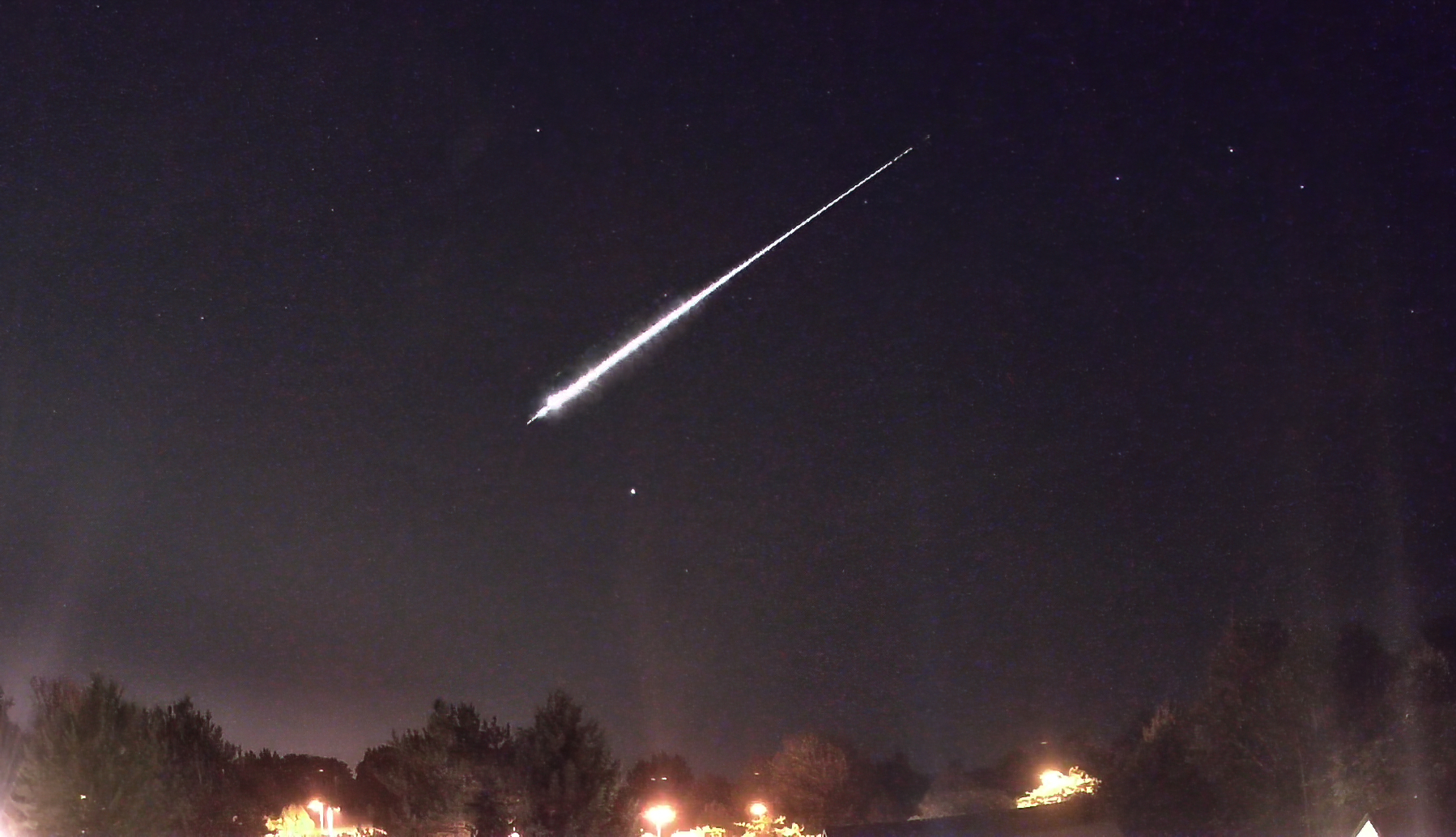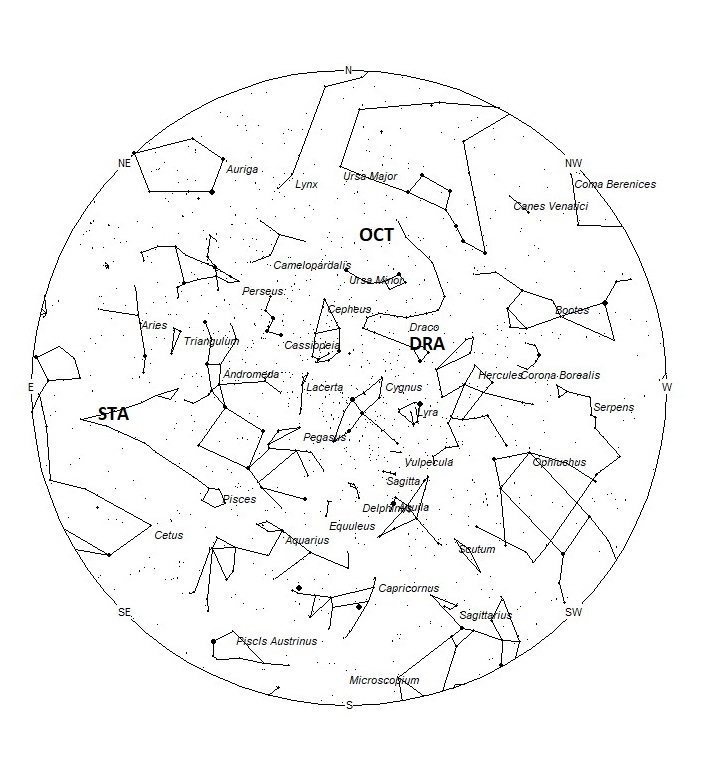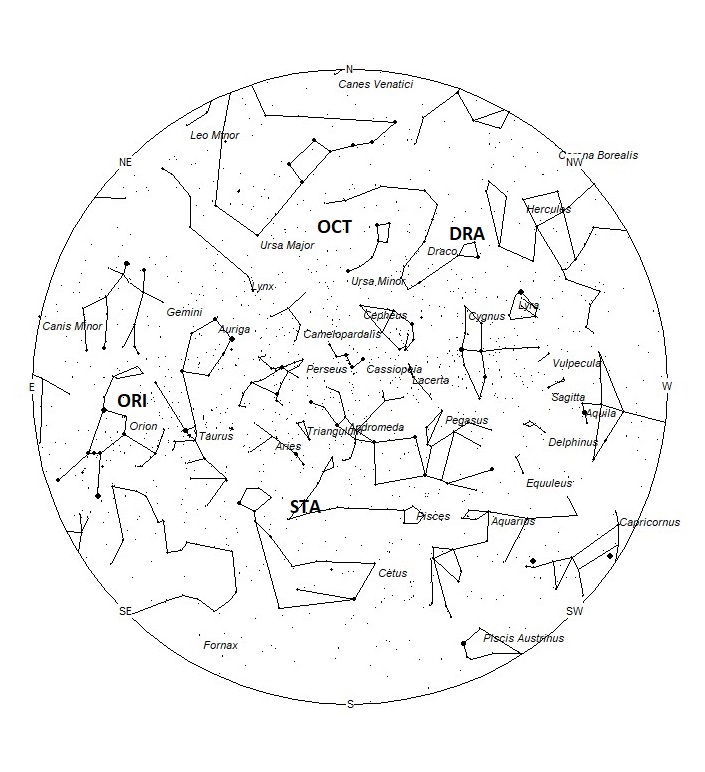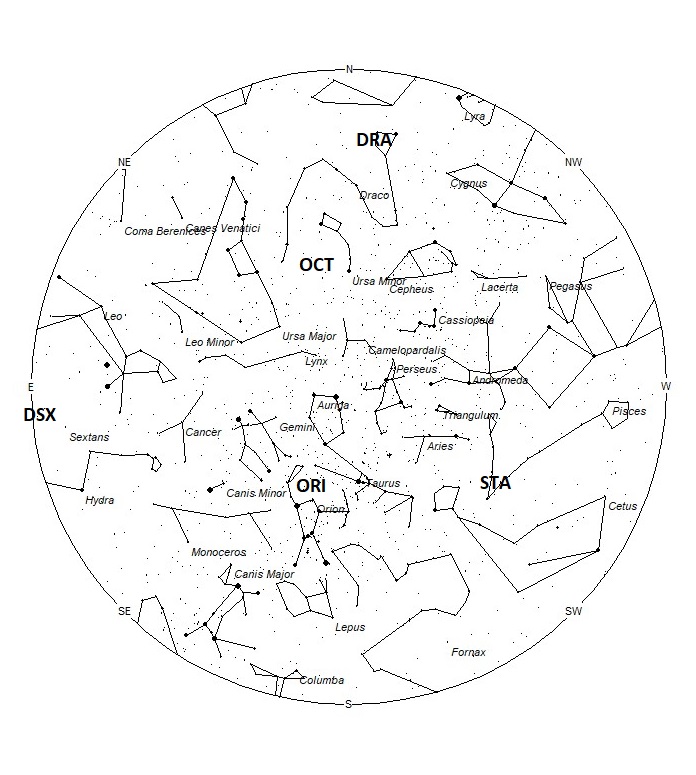 Jordan Ragsdale caught this bright fireball using an AllSky Camera System (https://www.allskycams.com/). This fireball occurred at 00:20 MDT (06:20 UT) on 12 August 2021, from Eagle, Idaho, USA ©Jordan Ragsdale
Jordan Ragsdale caught this bright fireball using an AllSky Camera System (https://www.allskycams.com/). This fireball occurred at 00:20 MDT (06:20 UT) on 12 August 2021, from Eagle, Idaho, USA ©Jordan RagsdaleMeteor activity increases in October when compared to September. A major shower (the Orionids) is active all month long and there are also many minor showers to be seen. Both branches of the Taurids become more active as the month progresses, providing slow, graceful meteors to the nighttime scene. The Orionids are the big story of the month reaching maximum activity on the 21st. This display can be seen equally well from both hemispheres which definitely helps out observers located in the sporadic-poor southern hemisphere this time of year. Sporadic activity is still good as seen from the northern hemisphere. In the southern hemisphere though, the sporadic activity is near its annual nadir.
During this period, the moon reaches its new phase on Wednesday October 6th. At that time the moon lies near the sun and is invisible at night. This weekend the waning crescent moon will rise during the late morning hours and will not interfere with meteor observing. The estimated total hourly meteor rates for evening observers this week is near 4 as seen from mid-northern latitudes (45N) and 3 as seen from tropical southern locations (25S). For morning observers, the estimated total hourly rates should be near 13 as seen from mid-northern latitudes (45N) and 10 as seen from tropical southern locations (25S). The actual rates will also depend on factors such as personal light and motion perception, local weather conditions, alertness, and experience in watching meteor activity. Note that the hourly rates listed below are estimates as viewed from dark sky sites away from urban light sources. Observers viewing from urban areas will see less activity as only the brighter meteors will be visible from such locations.
The radiant (the area of the sky where meteors appear to shoot from) positions and rates listed below are exact for Saturday night/Sunday morning October 2/3. These positions do not change greatly day to day so the listed coordinates may be used during this entire period. Most star atlases (available at science stores and planetariums) will provide maps with grid lines of the celestial coordinates so that you may find out exactly where these positions are located in the sky. I have also included charts of the sky that display the radiant positions for evening, midnight, and morning. The center of each chart is the sky directly overhead at the appropriate hour. These charts are oriented for facing south but can be used for any direction by rotating the charts to the desired direction. A planisphere or computer planetarium program is also useful in showing the sky at any time of night on any date of the year. Activity from each radiant is best seen when it is positioned highest in the sky, either due north or south along the meridian, depending on your latitude. It must be remembered that meteor activity is rarely seen at the radiant position. Rather they shoot outwards from the radiant, so it is best to center your field of view so that the radiant lies at the edge and not the center. Viewing there will allow you to easily trace the path of each meteor back to the radiant (if it is a shower member) or in another direction if it is sporadic. Meteor activity is not seen from radiants that are located far below the horizon. The positions below are listed in a west to east manner in order of right ascension (celestial longitude). The positions listed first are located further west therefore are accessible earlier in the night while those listed further down the list rise later in the night.
These sources of meteoric activity are expected to be active this week.
.
The Draconids (DRA) are expected to be active between 6-10 October this year. The radiant lies at 17:28 (262) +54. This position lies in southeastern Draco, 2 degrees southwest of the faint star known as Kuma (nu Draconis). These meteors are best seen just as soon as it becomes dark on the evening of October 8. With an entry velocity of 20 km/sec., the average Draconid meteor would be of very slow velocity. These meteors are poorly seen from the southern hemisphere due to the low radiant altitude seen from below the equator.
The Southern Taurids (STA) are active from September 10 through November 26 and peaks on October 10th. The center of the large STA radiant is currently located at 01:48 (027) +08. This position lies in southeastern Pisces, 1 degree south of the 4th magnitude star known as omicron Piscium. This radiant is best placed near 0200 LST, when it lies on the meridian and is located highest in the sky. Rates at this time should be near 2 per hour no matter your location. With an entry velocity of 27 km/sec., the average STA meteor would be of medium-slow velocity.
The Orionids (ORI) are active from October 2 though November 7, with maximum activity occurring on October 21. The radiant is currently located at 05:36 (084) +14, which places it in northern Orion, 4 degrees north of the 3rd magnitude star known as Meissa (lambda Orionis). Current rates are expected to be near 1 per hour, no matter your location. With an entry velocity of 66 km/sec., the average ORI meteor would be of swift velocity.
The Daytime Sextantids (DSX) are active from September 9-October 9, with maximum activity occurring on September 27. The current position of the radiant is 10:32 (158) 00. This position lies in central Sextans, near the spot occupied by the faint star known as beta Sextantis. This radiant is best placed near 0100 LST, when it lies on the meridian and is located highest in the sky. Rates at this time should be less than 1 per hour no matter your location. With an entry velocity of 32 km/sec., the average DSX meteor would be of medium-slow velocity. No matter your location, these meteors are difficult to observe as the radiant lies roughly 30 degrees from the sun. Therefore, these meteors may only be seen during the last hour prior to dawn, shooting upward from the eastern horizon.
The October Camelopardalids (OCT) are a recent discovery due to an outburst recorded by video cameras in 2005. Activity has occurred every year since and visual observers should be able to detect these meteors. This source is active from October 5-6 with maximum falling on the 5th. The radiant position lies near 10:56 (164) +79. This area of the sky is located in a barren area of extreme northeastern Camelopardalis. The easiest way to pinpoint the radiant is to extend a line eastward from the bottom two stars of the “bowl of the Little Dipper”. Extend another line northward from the “pointers” of the Big Dipper. Where these lines intersect is the location of the radiant. This area of the sky is above the horizon all night long but is best seen during the last dark hour before dawn when the radiant lies highest in a dark sky. Rates are expected to be low except near maximum activity. Due to the location near the northern pole, these meteors are not visible from the southern hemisphere. With an entry velocity of 47 km/sec., the average meteor from this source would be of medium velocity.
Note: There is the possibility of meteor activity produced by comet 15P/Finlay on October 7. South America best placed to view this activity. The radiant is expected to be located at 17:00 (255) -48, which is located in northern Ara, 6 degrees southwest of the 3rd magnitude star known as eta Scorpii. Any activity from this source is expected to be faint and very slow. *
*2021 IMO Meteor Shower Calendar by Jürgen Rendtel. Page 10
As seen from the mid-northern hemisphere (45N) one would expect to see approximately 10 sporadic meteors per hour during the last hour before dawn as seen from rural observing sites. Evening rates would be near 3 per hour. As seen from the tropical southern latitudes (25S), morning rates would be near 7 per hour as seen from rural observing sites and 2 per hour during the evening hours. Locations between these two extremes would see activity between the listed figures.
|
SHOWER |
DATE OF MAXIMUM ACTIVITY | CELESTIAL POSITION | ENTRY VELOCITY | CULMINATION | HOURLY RATE | CLASS |
| RA (RA in Deg.) DEC | Km/Sec | Local Summer Time | North-South | |||
| Draconids (DRA) | Oct 09 | 17:28 (262) +54 | 20 | 18:00 | <1 – <1 | III |
| Southern Taurids (STA) | Oct 10 | 01:48 (027) +08 | 30 | 02:00 | 2 – 2 | II |
| Orionids (ORI) | Oct 21 | 05:36 (084) +14 | 66 | 05:00 | 1 – 1 | I |
| Daytime Sextantids (DSX) | Oct 03 | 10:32 (158) 00 | 32 | 10:00 | <1 – <1 | IV |
| October Camelopardalids (OCT) | Oct 06 | 10:56 (164) +79 | 47 | 11:00 | <1 – <1 | II |






 You saw something bright and fast? Like a huge shooting star? Report it: it may be a fireball.
You saw something bright and fast? Like a huge shooting star? Report it: it may be a fireball.  You counted meteors last night? Share your results with us!
You counted meteors last night? Share your results with us!  You took a photo of a meteor or fireball? You have a screenshot of your cam? Share it with us!
You took a photo of a meteor or fireball? You have a screenshot of your cam? Share it with us!  You caught a meteor or fireball on video? Share your video with us!
You caught a meteor or fireball on video? Share your video with us!